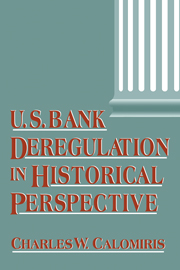Book contents
- Frontmatter
- Contents
- Acknowledgments
- Introduction
- 1 Regulation, industrial structure, and instability in U.S. banking: An historical perspective
- 2 The origins of banking panics: Models, facts, and bank regulation (with Gary Gorton)
- 3 The origins of federal deposit insurance (with Eugene N. White)
- 4 The costs of rejecting universal banking: American finance in the German mirror
- 5 The evolution of market structure, information, and spreads in American investment banking (with Daniel M. G. Raff)
- 6 Universal banking, “American style”
- General Index
- Index of Names
6 - Universal banking, “American style”
Published online by Cambridge University Press: 11 September 2009
- Frontmatter
- Contents
- Acknowledgments
- Introduction
- 1 Regulation, industrial structure, and instability in U.S. banking: An historical perspective
- 2 The origins of banking panics: Models, facts, and bank regulation (with Gary Gorton)
- 3 The origins of federal deposit insurance (with Eugene N. White)
- 4 The costs of rejecting universal banking: American finance in the German mirror
- 5 The evolution of market structure, information, and spreads in American investment banking (with Daniel M. G. Raff)
- 6 Universal banking, “American style”
- General Index
- Index of Names
Summary
American corporate banking has undergone enormous change over the past two decades. That change reflects a combination of long-run competitive pressures and short-run performance problems that led U.S. banks and their regulators to a new American version of global universal banking. From the perspective of the scale and scope of banks, these changes represent a convergence of U.S. banks to international norms in banking. At the same time, the U.S. version of universal banking entails novel linkages between banks and financial markets in the pursuit of enhancing bank-customer relationships. These new linkages give universal banking a new complexity and richness which banks outside the United States will increasingly imitate.
6.1 Introduction
The last decade has witnessed significant convergence in the practice and regulation of banking across countries, and the United States has done more than its share of changing. Differences remain in structure, powers, and regulation across countries. Nevertheless, banking has become much more uniform internationally, and there is a good chance that current changes being contemplated in Europe, the United States, Japan, and Latin America will reinforce the trend toward convergence.
More important than any single similarity in law, regulation, or practice is the common trend in banking “philosophy.” I will argue that global competition in financial services should be credited with producing regulatory, practical, and philosophical convergence, and with making bankers and regulators more willing to learn from each other's experiences.
The United States – uncharacteristically – has been a prime example of this convergence process.
- Type
- Chapter
- Information
- U.S. Bank Deregulation in Historical Perspective , pp. 334 - 349Publisher: Cambridge University PressPrint publication year: 2000
- 1
- Cited by



